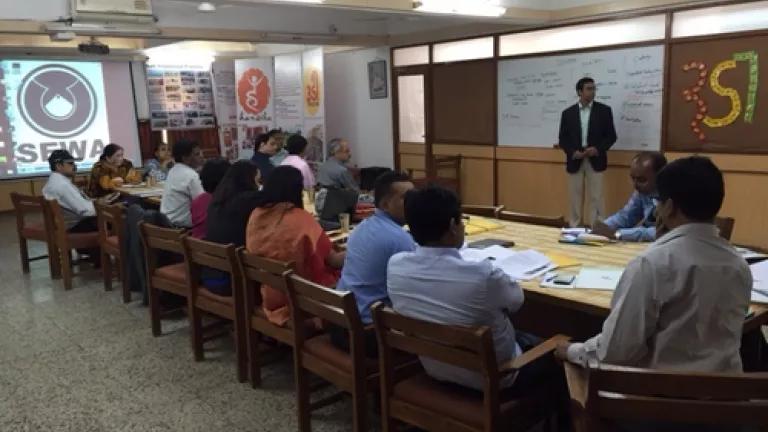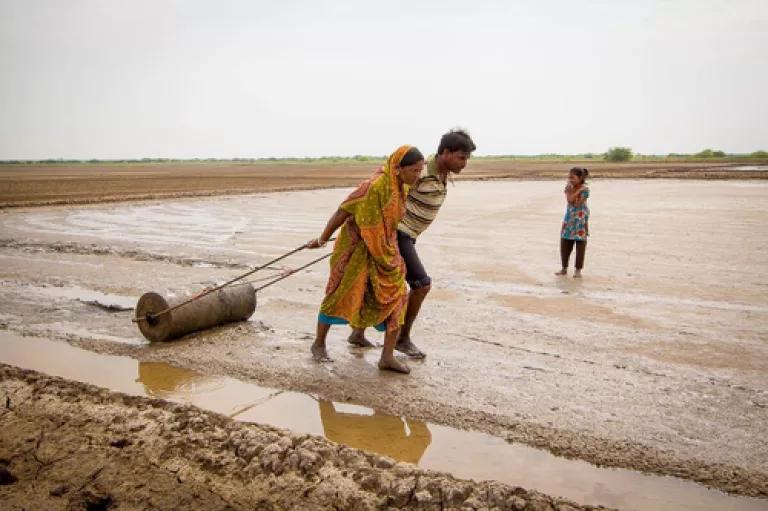Worth Their Salt: How Clean Energy is Powering a Breakthrough Opportunity for Saltpan Farmers in Gujarat's Desert - Part 2

In this second part of the energy access blog series, we discuss latest developments and financing opportunities for replacing diesel pumps with solar-powered water pumps to harvest salt in India. Part 1 on my colleague Anjali Jaiswal's blog highlights the findings from two pilot projects conducted by our partners SEWA and analyzed in our recent case study.
Access to clean energy finance can provide a breakthrough solution to improve livelihoods of the 43,000 salt farmers (agarias) of Little Rann of Kutch, who collectively produce 70% of India's salt, and yet earn barely enough to provide food for their family. The two innovative pilot projects highlighted in Part 1 of this blog series reveal the remarkable economic, social, and environmental opportunities available to saltpan farmers by switching from diesel to solar-powered pumps. Powering water pumps that traditionally use expensive diesel with solar energy can save diesel fuel costs that currently make up to 40% of a farmer's annual revenue. Shifting to solar energy can also help farmers increase efficiency and salt harvest outputs, and improve their livelihoods. The agarias face financing hurdles to make the switch to solar, including high upfront costs, high interest rates and lack of access to formal financing.
To understand and address these financial barriers, SEWA and NRDC convened a roundtable last month with leading regional and national financial institutions, equipment suppliers, and other stakeholders in Gujarat to discuss scalable financing solutions. Roundtable participants included government representatives from the Ministry of New and Renewable Energy (MNRE) and Gujarat Corporate Social Responsibility Authority. Participating financiers included representatives from National Bank for Agriculture and Rural Development (NABARD), Small Industries Development Bank of India (SIDBI), Grassroot Trading Network, and many leading private and public sector banks. Solar water pump suppliers, industry and academic stakeholders who attended included El Sol Energy Systems, Claro Energy, Grundfos Pumps, Pegasus Semiconductor, and CEPT University.
Switching to solar is not just environmentally beneficial but also presents a strong economic case for the farmers and the investors alike. Our financial analysis of the two pilot projects reveal solar pumps break even in less than 4 years on the initial investment. Given the durability of the equipment, and corresponding positive annual cash flows, solar pumps are an attractive, low risk asset for lenders. At an average price of Rs 200,000 per solar pump, the total size of the market is about Rs 860 crore (~US $150 million).

Presently, there aren't any financial solutions available to salt farmers to switch to solar, and it may not be possible to match this level of funding with one single solution. The roundtable discussion centered on finding the best approaches to provide low-cost, long-term finance for the agarias, with a view that such a solution can work in other similar energy access projects. The roundtable participants came up with a number of suggestions for innovative financial solutions. In the discussion below, we begin with the traditional financing mechanisms that can be effective but need to be adapted to the needs of the salt farmers.
Conventional approaches and challenges
Domestic bank lending: Domestic banks from both, public and private sectors demonstrated an interest in expanding financial access to the salt farmers. Renewable energy projects now count towards banks' priority sector lending targets, giving them a stronger incentive to lend. However, there are some hurdles that make this a challenging proposition. Banks have to follow strict 'know your customer (KYC)' requirements as stipulated by the central bank's regulations in India. Salt farmers, without acceptable identification or proof of permanent residence, invariably fail to meet these requirements. Moreover, in the absence of an established credit history, and lack of collateral, salt farmers are perceived as high risk. Finally, bank lending rates in India are very high, and together with the high cost of servicing this distant and disparate group of customers, makes the loan an unviable proposition for the farmers.
To overcome these barriers, in the past, banks, and microfinance institutions, have worked with self-help groups (SHG) for pooling the repayment risk. However, typically, micro-lending through the SHG model is for a much lower ticket size than what is required to purchase solar pumps for each member of the group, and therefore may not be an effective solution.
Government subsidies: The MNRE has a solar irrigation pump subsidy scheme. The Ministry is keen to extend clean energy access and financial inclusion to the salt farmers. However, the way the current scheme is structured poses several limitations. The subsidy requires meeting prescribed technical specifications and procurement through empaneled suppliers, currently none of which service the salt marsh region. However, to support this worthy project, MNRE has approved the technical specification developed specifically for the salt farmers by SEWA and NRDC, and is open to accrediting more regional suppliers.
NABARD is the implementing agency for solar pump subsidy and provides funding of up to INR 50,000 for solar pumps (less than 2 hp). Here's how the NABARD subsidy works:
The farmer applies to a bank -> bank does due diligence and ensures KYC norms are met -> bank extends loan to the farmer -> NABARD releases subsidy which is deposited into a 'Subsidy Reserve Fund Account' of the borrower -> this fund is adjusted against final loan instalments, provided the borrower has repaid the remaining instalments.
Since the subsidy is back ended, applicable only when all the preceding installments have been paid, it does not provide much comfort to the banks in lowering their risk assessment, especially for perceived high risk clients like the salt farmers. Additionally, with the KYC requirements, the process faces the same challenges described in the conventional bank loan process.
Given these challenges with the conventional lending solutions, the roundtable discussants brainstormed on creating innovative solutions that are practical and affordable for the farmers. In the next part of the blog series we summarize some of these promising financial solutions that can potentially give every farming family access to clean energy, in turn, giving them the opportunity to vastly improve their livelihood.
Co-authored by Meredith Connolly, Energy Law & Policy Fellow.

